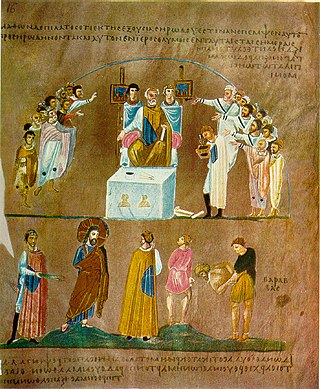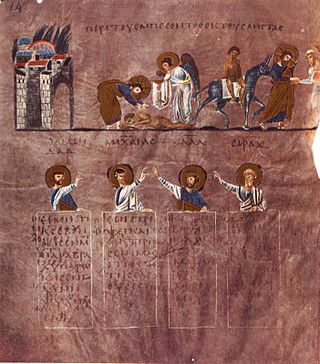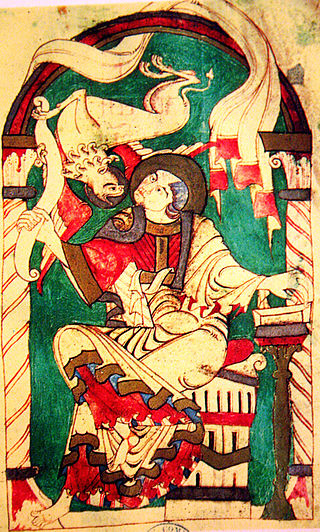Related Research Articles

The Codex Argenteus is a 6th-century illuminated manuscript, originally containing part of the 4th-century translation of the Christian Bible into the Gothic language. Traditionally ascribed to the Arian bishop Wulfila, it is now established that the Gothic translation was performed by several scholars, possibly under Wulfila's supervision. Of the original 336 folios, 188—including the Speyer fragment discovered in 1970—have been preserved, containing the translation of the greater part of the four canonical gospels. A part of it is on permanent display at the Carolina Rediviva building in Uppsala, Sweden, under the name "Silverbibeln".

The Rossano Gospels, designated by 042 or Σ, ε 18 (Soden), held at the cathedral of Rossano in Italy, is a 6th-century illuminated manuscript Gospel Book written following the reconquest of the Italian peninsula by the Byzantine Empire. Also known as Codex purpureus Rossanensis due to the reddish-purple appearance of its pages, the codex is one of the oldest surviving illuminated manuscripts of the New Testament. The manuscript is famous for its prefatory cycle of miniatures of subjects from the Life of Christ, arranged in two tiers on the page, sometimes with small Old Testament prophet portraits below, prefiguring and pointing up to events described in the New Testament scene above.

The Codex Alexandrinus, designated by the siglum A or 02, δ 4, is a manuscript of the Greek Bible, written on parchment. Using the study of comparative writing styles (palaeography), it has been dated to the fifth century. It contains the majority of the Greek Old Testament and the Greek New Testament. It is one of the four Great uncial codices. Along with Codex Sinaiticus and Vaticanus, it is one of the earliest and most complete manuscripts of the Bible.

Sarezzano is a comune (municipality) in the Province of Alessandria in the Italian region Piedmont, located about 100 kilometres (62 mi) east of Turin and about 25 kilometres (16 mi) east of Alessandria. As of 31 December 2004, it had a population of 1,171 and an area of 13.8 square kilometres (5.3 sq mi).
Codex Colbertinus, designated by 6 or c, is a Latin manuscript of the Bible. Its version of the four Gospels and Book of Acts follows the Vetus Latina, while the rest of the New Testament follows the Vulgate. It was written in the 11th or 12th century, probably in southern France.

Codex Petropolitanus Purpureus, designated by N or 022, ε 19, is a Greek New Testament codex containing the four Gospels. Using the study of comparative writing styles (palaeography), it has been assigned to the 6th century CE.

Purple parchment or purple vellum refers to parchment dyed purple; codex purpureus refers to manuscripts written entirely or mostly on such parchment. The lettering may be in gold or silver. Later the practice was revived for some especially grand illuminated manuscripts produced for the emperors in Carolingian art and Ottonian art, in Anglo-Saxon England and elsewhere. Some just use purple parchment for sections of the work; the 8th-century Anglo-Saxon Stockholm Codex Aureus alternates dyed and un-dyed pages.
The Garland of Howth, also known as the Codex Usserianus Secundus, designated by r2 or 28, is a fragmentary 8th to 10th century Latin Gospel Book now in Trinity College Dublin as MS. 56.
The Codex Vindobonensis Lat. 1235, designated by i or 17, is a 6th-century Latin Gospel Book. The manuscript contains 142 folios. The text, written on purple dyed vellum in silver ink, is a version of the old Latin. The Gospels follow in the Western order.

The Codex Veronensis, designated by siglum b or 4, is a 5th century Latin Gospel Book. The text, written on purple dyed vellum in silver and occasionally gold ink, is a version of the old Latin. The Gospels follow in the Western order.
The Codex Palatinus, designated by e or 2, is a 5th-century Latin Gospel Book. The text, written on purple dyed vellum in gold and silver ink, is a version of the old Latin. Most of the manuscript was in the Austrian National Library at Vienna until 1919, when it was transferred to Trento, where it is now being kept as Ms 1589 in the Library of Buonconsiglio Castle. Two leaves were separated from the manuscript in the 18th century: one is now in the library of Trinity College, Dublin, the other in the British Library in London.

The Codex Corbeiensis I, designated by ff1 or 9, is an 8th, 9th, or 10th-century Latin New Testament manuscript. The text, written on vellum, is a version of the old Latin. The manuscript contains 39 parchment folios with the text of the four Gospels, Acts of the Apostles, and General epistles.
The Codex Corbeiensis II, designated by ff2 or 8, is a 5th-century Latin Gospel Book. The text, written on vellum, is a version of the old Latin. The manuscript contains 190 parchment folio with the text of the four Gospels with lacunae. Written in a beautiful round uncial hand.
The Codex Curiensis known also as Fragmenta Curiensia, designated by a2 or 16, is a 5th-century AD Latin manuscript of the New Testament. The text, written on vellum, is a version of the old Latin. The manuscript contains the fragments of the Gospel of Luke, on exactly two parchment leaves.
The Codex Mediolanensis or Fragmentum Mediolanense, designated by g2 or 52, is a 10th or 11th century Latin manuscript of the New Testament. The text, written on vellum, is a version of the Vetus Latina. The manuscript contains the fragments of the Gospel of Luke, on only 2 parchment leaves. It was a lectionary.
The Codex Sangermanensis I, designated by g1 or 7, is a Latin manuscript, dated AD 822 of portions of the Old Testament and the New Testament. The text, written on vellum, is a version of the Latin. The manuscript contains the Vulgate Bible, on 191 leaves of which, in the New Testament, the Gospel of Matthew contain Old Latin readings. It contains Shepherd of Hermas.
The Codex Complutensis I, designated by C, is a 10th-century codex of the Christian Bible. It is written on vellum with Latin text mainly following the Vulgate. Parts of the Old Testament present an Old Latin version.
The Codex Bernensis known also as Fragmenta Bernensia, designated by t or 19, is a 5th or 6th century Latin manuscript of the New Testament. The text, written on vellum, is a version of the old Latin. The manuscript contains the fragments of the Gospel of Mark, on only 2 parchment leaves. Written in two columns per page, 23 lines per column. It is a palimpsest.

The Codex Claromontanus V, designated by h in traditional system or by 12 in the Beuron system, is a 4th or 5th century Latin manuscript of the New Testament. The text, written on vellum.
The Codex Theodulphianus, designated Θ, is a 10th-century Latin manuscript of the Old and New Testament. The text, written on vellum, is a version of the Latin Vulgate Bible. It contains the whole Bible, with some parts written on purple vellum.
References
- ↑ "Codex Purpureus Sarzanensis in the Diocese of Tortona". Roman Catholic Diocese of Tortona . Archived from the original on October 8, 2018. Retrieved Dec 30, 2018., with illustrations of the whole manuscript
- 1 2 3 Scrivener, Frederick Henry Ambrose; Edward Miller (1894). A Plain Introduction to the Criticism of the New Testament, Vol. 2 (4 ed.). London: George Bell & Sons. p. 48.
- 1 2 Bruce M. Metzger, The Early Versions of the New Testament, Oxford University Press, 1977, p. 298.